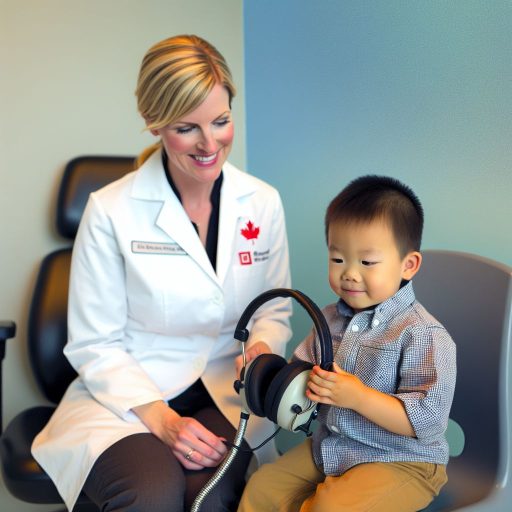Introduction to Speech Therapy and its Importance
Speech therapy plays a crucial role in communication development.
It addresses various speech and language disorders effectively.
Many people struggle with speech challenges due to various reasons.
These include developmental disorders, injuries, or medical conditions.
Thus, speech therapy becomes essential for improving communication skills.
In addition, it enhances social interaction and overall confidence.
Therapists employ various techniques tailored to individual needs.
This personalization allows for optimal progress in therapy sessions.
Moreover, speech therapy can help in cognitive-communication disorders.
People with stroke or brain injury can benefit significantly from it.
Overall, speech therapy is vital for personal and professional growth.
Effective communication is important in every aspect of life.
Therefore, seeking professional help for speech therapy is important.
With proper techniques and support, individuals can achieve their goals.
Overview of Common Speech Disorders
Understanding Speech Disorders
Speech disorders affect an individual’s ability to communicate effectively.
These disorders may involve problems with articulation, fluency, or voice quality.
Common causes include developmental issues, neurological conditions, and injuries.
Articulation Disorders
Articulation disorders involve difficulty producing specific sounds correctly.
These issues often include substituting, omitting, or distorting sounds.
For example, a child may say “wabbit” instead of “rabbit.”
An articulation disorder can impact a person’s clarity of speech.
Fluency Disorders
Fluency disorders affect the rhythm and flow of speech.
Stuttering is the most recognized fluency disorder.
This can cause interruptions in speech, leading to frustration or anxiety.
Individuals may have repetitions or prolonged sounds that disrupt communication.
Unlock Your Career Potential
Visualize a clear path to success with our tailored Career Consulting service. Personalized insights in just 1-3 days.
Get StartedVoice Disorders
Voice disorders affect vocal quality, pitch, or loudness.
These disorders may stem from overuse, strain, or medical conditions.
Common symptoms include hoarseness or a weak voice.
Voice disorders can significantly impact social interactions and confidence.
Language Disorders
Language disorders involve challenges understanding or using spoken language.
These include difficulties with vocabulary, grammar, and conversation skills.
Such disorders may occur in children and can persist into adulthood.
Individuals might struggle to express their thoughts effectively.
Social Communication Disorders
Social communication disorders affect interpersonal communication skills.
These issues can involve difficulties in conversation and social cues understanding.
People with this disorder may struggle to take turns in conversation.
This may lead to misunderstandings and social isolation.
Assessment Techniques Used in Speech Therapy
Overview of Assessment Techniques
Speech therapy assessments play a crucial role in identifying communication disorders.
These evaluations provide detailed insights into a person’s speech and language abilities.
Professionals utilize various techniques to conduct comprehensive assessments.
Standardized Tests
Standardized tests are essential for measuring specific language skills.
These assessments offer quantifiable scores for comparison with age-appropriate norms.
Examples of standardized tests include the Goldman-Fristoe Test of Articulation.
Additionally, the Peabody Picture Vocabulary Test assesses receptive vocabulary.
Dynamic Assessment
Dynamic assessment evaluates a person’s potential for learning new skills.
It emphasizes the process of learning rather than just the final score.
This technique allows therapists to identify strengths and weaknesses effectively.
Professionals often use interactive methods during dynamic assessments.
Parent and Caregiver Interviews
Interviews with parents and caregivers provide valuable insights into a child’s communication habits.
These discussions reveal information about everyday language use at home.
They also help identify context-specific challenges faced by the individual.
Such input is crucial for creating personalized therapy plans.
Observation Techniques
Observation plays a vital role in assessing communication skills in natural settings.
Therapists take note of speech patterns and interaction styles during play or conversation.
This technique reveals functional language usage beyond structured assessments.
Furthermore, observing a child in different environments can highlight diverse challenges.
Speech and Language Sample Analysis
Analyzing speech and language samples offers practical insights into communication abilities.
Therapists collect samples during spontaneous conversation or structured tasks.
This analysis examines aspects such as vocabulary use, sentence structure, and fluency.
Such detailed evaluation informs targeted intervention strategies.
Technology-Assisted Assessments
Technology plays an increasingly important role in speech therapy assessments.
Apps and software can record, analyze, and provide feedback on speech patterns.
This approach provides engaging ways to assess communication abilities.
Moreover, technology can streamline data collection and analysis processes.
Uncover the Details: Choosing The Right Chiropractor For Your Needs
Articulation Therapy Techniques and Approaches
Overview of Articulation Therapy
Articulation therapy focuses on improving speech clarity.
It addresses specific sounds a person struggles to pronounce.
Professionals often design personalized therapy plans.
These plans include various techniques tailored to individual needs.
Targeted Techniques
Effective articulation therapy utilizes targeted techniques.
One widely used method is phonetic placement.
This method instructs clients on the correct articulation position.
Another technique is auditory discrimination exercises.
These exercises help clients identify sound differences.
Phonetic Placement Method
Phonetic placement involves teaching correct tongue and lip placement.
This technique helps clients produce specific sounds accurately.
For instance, therapists may use visual aids to demonstrate.
Encouraging clients to touch their articulators aids comprehension.
Auditory Discrimination Exercises
Auditory discrimination exercises focus on listening skills.
Clients learn to differentiate between similar sounds.
Activities can include repetition and minimal pairs drills.
This practice enhances overall sound awareness.
Supplementary Techniques
In addition to targeted techniques, supplementary methods exist.
One method involves using visual imagery.
Clients visualize sound production to improve articulation.
Another supplementary technique is the use of games.
Games make learning enjoyable while reinforcing skills.
Visual Imagery Technique
Visual imagery allows clients to picture sound formation.
Therapists may encourage clients to imagine sounds as shapes.
This technique helps solidify understanding of sound production.
Incorporating Games
Therapists can utilize games to enhance engagement.
Fun activities motivate clients to practice articulation.
Examples include matching games or sound bingo.
These methods create a dynamic learning environment.
Progress Tracking
Tracking progress is essential in articulation therapy.
Professionals monitor client improvement through assessments.
Regular feedback sessions help clients stay motivated.
Modification of techniques occurs based on individual progress.
Techniques Overview
Articulation therapy encompasses various techniques and approaches.
These methods aim to improve clarity and confidence in speech.
By using structured techniques, professionals effectively support clients.
Find Out More: How Audiologists Support Patients With Hearing Aids
Language Intervention Strategies for Children
Enhancing Verbal Communication
Engaging children in conversations facilitates verbal communication.
Use open-ended questions to encourage longer responses.
Additionally, narrate daily activities to build vocabulary.
Incorporate storytelling to spark imagination and language use.
Expanding Vocabulary Skills
Introduce new words through playful activities.
Utilize flashcards to reinforce learning and retention.
Group words by themes to enhance conceptual understanding.
Encourage children to use new words during playtime.
Promoting Listening Comprehension
Engage children with interactive reading sessions.
Ask them to predict what happens next in stories.
Encourage summarization of stories to assess understanding.
Utilize songs and rhymes to make learning enjoyable.
Utilizing Visual Supports
Use pictures and symbols to represent words and ideas.
Display visual schedules to aid understanding of routines.
Incorporate graphic organizers for complex concepts.
Visual aids can significantly enhance memory recall.
Encouraging Peer Interaction
Arrange group activities that require collaboration.
Role-playing can build social communication skills.
Encourage turn-taking during games to practice conversational skills.
Peer interactions create a supportive learning environment.
Incorporating Technology
Leverage educational apps to motivate children.
Utilize speech recognition software for practice.
Online resources can provide varied learning experiences.
Technology can make language learning engaging and fun.
See Related Content: When to Consult a Podiatrist for Diabetic Foot Care
Fluency Techniques for Stuttering Management
Overview of Fluency Techniques
Fluency techniques aim to reduce stuttering and improve speech flow.
Professionals commonly use these techniques in therapy sessions.
Each method focuses on building confidence and enhancing communication.
Slow Speech Techniques
One effective method involves instructing clients to speak slowly.
This technique allows for clearer speech and better control.
Practicing prolonged speech can further enhance fluency.
Additionally, modeling slow speech helps individuals mimic examples.
Breathing Techniques
Controlled breathing techniques play a vital role in fluency.
For instance, diaphragmatic breathing supports steady speech production.
Clients can practice inhaling deeply before speaking.
Exhaling slowly while talking promotes relaxation and reduces tension.
Gesture and Body Language
Utilizing gestures can significantly aid fluency during speech.
Encouraging clients to use hand movements helps them express ideas.
This strategy allows for better coordination between speech and movement.
Moreover, positive body language increases confidence in communication.
Positive Reinforcement
Positive reinforcement methods are crucial for motivation.
Therapists often praise clients after successful practice sessions.
Offering rewards can encourage persistence and commitment.
Furthermore, tracking progress helps clients visualize improvements.
Practice in Real-Life Situations
Real-life practice enhances the effectiveness of fluency techniques.
Clients benefit from participating in everyday conversations.
Role-playing can simulate various social situations effectively.
Additionally, professionals encourage gradual exposure to challenging contexts.
Find Out More: The Science Behind Kinesiology and Human Movement

Voice Therapy Techniques for Vocal Health
Understanding Vocal Health
Vocal health is essential for effective communication.
It involves maintaining the vocal cords and surrounding structures.
Professionals often emphasize preventive measures.
Hydration Techniques
Staying well-hydrated is crucial for vocal health.
Drink plenty of water throughout the day.
Herbal teas can also provide soothing effects.
Avoid caffeinated beverages, as they can cause dryness.
Consistent Intake
Make a habit of carrying a water bottle.
Set reminders to drink water regularly.
This practice creates awareness about hydration.
Environmental Considerations
Use a humidifier during dry seasons.
Maintain an optimal humidity level in your environment.
Dry air can irritate the vocal cords.
Vocal Warm-Ups
Warming up your voice prepares it for use.
Start with gentle humming to ease tension.
Gradually increase your pitch and volume.
Breathing Exercises
Breathing exercises strengthen diaphragm support.
Practice deep breathing techniques daily.
Inhale deeply through the nose and exhale through the mouth.
Vocal Exercises
Engage in specific vocal exercises regularly.
Use scales to help with pitch accuracy.
Incorporate lip trills to relax the vocal cords.
Using Proper Technique
Employ proper vocal technique when speaking or singing.
This includes maintaining good posture and alignment.
Speak at a comfortable volume to avoid strain.
Microphone Technique
When using a microphone, adjust the distance properly.
Avoid straining your voice by over-projecting.
Utilizing a good mic can enhance vocal clarity.
Resting the Voice
Resting your voice is vital for recovery.
Avoid talking or whispering when your voice feels strained.
Implement vocal rest periods into your daily routine.
Seeking Professional Guidance
Consulting a speech therapist can be beneficial.
Professionals can tailor specific exercises for individual needs.
Regular assessments help monitor vocal progress.
Augmentative and Alternative Communication (AAC) Methods
What is AAC?
Augmentative and Alternative Communication (AAC) refers to communication methods beyond speech.
It includes both aided and unaided systems.
Aided systems involve tools like devices or symbols.
Conversely, unaided systems rely on body language and gestures.
Types of AAC Devices
AAC devices can greatly assist individuals in communication.
These devices vary in complexity and functionality.
- Simple devices include communication boards.
- Advanced devices are dynamic display tablets.
- Some devices feature voice output capabilities.
Symbol Systems in AAC
Symbol systems play a critical role in AAC methods.
They help users convey their thoughts effectively.
- Pictorial symbols depict specific objects or actions.
- Text-based symbols represent written language.
- Sign language provides a manual communication form.
Benefits of AAC
AAC provides numerous advantages to users.
It enhances communication abilities significantly.
Importantly, AAC promotes social engagement and interaction.
Moreover, it improves the quality of life for many individuals.
Challenges in Implementing AAC
Despite its benefits, challenges exist in AAC implementation.
Access to devices can pose significant obstacles.
Additionally, users may face integration issues in daily life.
Finally, training for effective device usage is essential.
Technology Integration in Speech Therapy Sessions
Benefits of Technology in Therapy
Technology enhances speech therapy sessions significantly.
It offers interactive tools that engage clients effectively.
Furthermore, technology provides therapists with valuable data.
This data aids in tracking progress over time.
Moreover, it improves communication between therapists and clients.
Types of Technologies Employed
Various technologies facilitate speech therapy practices.
Speech-generating devices assist clients in verbal communication.
Apps designed for speech improvement are also popular.
Teletherapy platforms expand access to therapy services.
These platforms enable remote sessions for convenience.
Implementation in Sessions
Therapists need to assess individual client needs first.
This assessment helps determine the right tools to use.
Next, they incorporate selected technologies into the session.
For instance, apps may focus on specific speech sounds.
Moreover, therapists can use videos to demonstrate techniques.
Challenges to Consider
Despite benefits, some challenges exist in technology integration.
Access to reliable technology can be an issue for some clients.
Additionally, therapists must be trained on new tools.
They should ensure technology does not distract from therapy objectives.
Future Trends in Speech Therapy Technology
Future technologies may further revolutionize speech therapy.
Artificial intelligence is gaining traction in assessments.
Virtual reality might create immersive practice environments.
Moreover, more interactive and personalized tools will likely emerge.
All these developments promise enhanced treatment outcomes.
Additional Resources
Therapy-based allied health delivery in residential aged care, trends …




